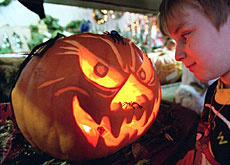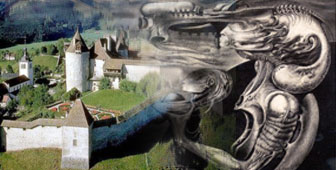Castle reveals secret of severed hand

A grisly relic on show at the medieval Gruyères Castle in western Switzerland is expected to be a star attraction this Halloween.
A severed hand in its own display cabinet has been helping to draw record numbers of daytrippers to the picturesque hilltop castle village.
For more than 100 years, mystery has shrouded the ancient shrunken limb.
It took one of Switzerland’s most eminent anthropologists to uncover the truth, in a research project started in 2003.
Legends
The castle was formerly the regional seat of power, occupied from 1080 to 1554 by the 19 counts of Gruyères.
Legend has it that soldiers who joined the first crusade in 1099 brought the hand back as a talisman from the Holy Land.
Another story associates the hand with the battle of La Tine in 1476, when Count Louis of Gruyères fought off an invasion by 500 knights of Savoy and Burgundy. The hand, said to belong to one of the soldiers, was taken back to Gruyères to commemorate the glorious victory.
A year after the death of Count Louis, in 1493, the castle is said to have suffered a devastating fire, which destroyed everything but the dungeons. The story goes that all that was recovered from the blaze was a charred hand. This was given to the Countess Claude de Seyssel, who rebuilt the castle and kept the hand as a reminder of the catastrophe
Other theories were that the hand had been hacked off a thief, or belonged to a witch who was burned at the stake.
Detective work
The castle curator turned to a leading specialist in European mummies for help in unravelling the mystery.
Bruno Kaufmann from the anthropology research institute in Aesch found that the corpse – probably that of a male – had been subjected to the classic mummification treatment used by well-heeled Egyptians up to the third century.
Kaufmann asked a textile specialist to analyse the bandages around the hand. He told swissinfo: “We could see that tar had been used in the embalming process, which was typical for Egyptian mummies from this era.” It also accounts for the dark colour of the limb.
He compared the skin pigment of the hand with that of a mummified Egyptian foot he had acquired, and concluded that the same technique had been used.
Mummy craze
From the end of the Middle Ages up until early modern times, mummy parts were thought to have healing qualities. Mummified limbs were ground down and mixed with honey and wine to form a tonic or poultice, which could be applied to the skin.
At the end of the 18th century, a Napoleonic expedition to Egypt awakened an interest in the world of the pharaohs.
“The export of mummies was outlawed by this time, so traders smuggled severed mummified limbs instead, which were easier to transport,” Kaufmann explained.
These appeared at art markets and were snapped up by museums and private collectors. Kaufmann believes that it was during this period that the severed hand was acquired by a rich Geneva dynasty, the Bovy and Balland families, who bought the castle of Gruyères in 1848.
On the ground floor of the dungeon, they set up a curiosity chamber, where the limb was put on show.
The creepy claw now resides in a first floor corridor, and visitors are free to gaze at it for as long as they please. Hopefully, it doesn’t carry a curse.
swissinfo, Julie Hunt in Gruyères
In Switzerland there are 20 mummies from medieval times and 100 Egyptian mummies.
Many were brought back from the Napoleonic wars by soldiers.
The composer Anton Bruckner was the first person to be mummified in formalin (1896).
The last person to be mummified in Switzerland was Czech composer Bohuslav Martinu (1959).
The truth surrounding a gruesome relic on display at Gruyères castle has finally been uncovered.
Tourists are flocking to look at the ancient artefact after so many years of speculation.

In compliance with the JTI standards
More: SWI swissinfo.ch certified by the Journalism Trust Initiative











You can find an overview of ongoing debates with our journalists here . Please join us!
If you want to start a conversation about a topic raised in this article or want to report factual errors, email us at english@swissinfo.ch.